Frunner
Due to my love for running, a professional peer & I designed an enhanced running application and took it all the way through the interaction design phase.
Our team designed an application that will create an enhanced running experience through integrating different touchpoints that casual runners have during their daily experience. Our product comprises two differentiating features that expand upon existing products in the market today- real-time tracking via a customized map view that allows users to connect with other runners within a city & create a personal profile to to inhibit user-generated content such as running gear, music + podcast playlists, running statistics, and personal experiences.

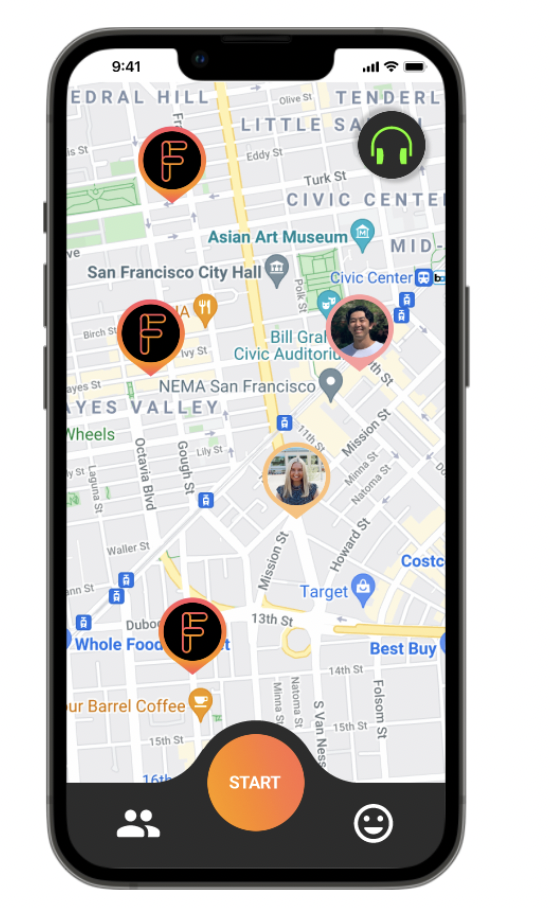

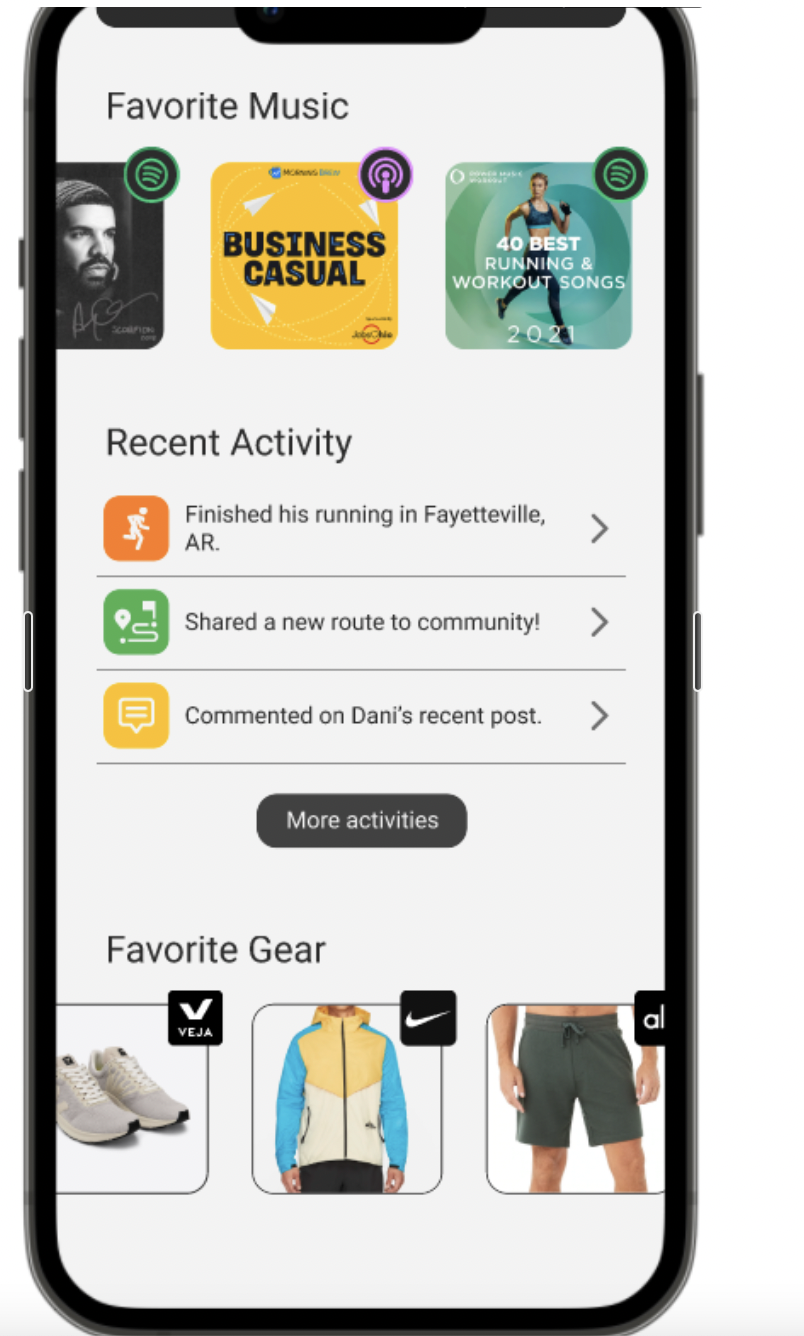
Problem Defined.
The aim of our product is to connect those who participate in an individual sport such as running. Within larger cities, our team noticed that there are many runners who run along the same routes everyday but still don’t have a sense of connection due to the nature of the sport being an independent activity. With our application, ‘frunners’ will be able to connect with those around them through a customized map view that shows them who is around them in real-time, their running statistics, and what content they are engaging with.
Idea Validation
Exploratory Research
Our team used this phase of research to understand who the current players are within the fitness tech industry and what types of consumers comprise it.
Our team used ESRI tapestry segment reports to understand demographics within different zip codes and what common behaviors flowed within them.
Industry + Market Analysis
From there, we understood what external market factors are influencing current state of fitness applications, their current market saturation, and potential growth levers. This helped us identify gaps in the market and where we needed to focus on in terms of diffentiating our app.
Competitive Analysis
Our team focused on understanding what competitors are doing well + where they were lacking in enhancing the running experience. This phase was important because it validated that we weren’t re-inventing the wheel- but more so, improving upon a solution that already exists today.
Qualitative + Quantitative Research
Our team used ethnographic studies to observe and speak with runners who consider themselves ‘advanced, recreational’ participants of the sport. This allowed our team to conduct early validation that we are solving a real problem.
Go-To-Market Strategy
We plan to place ourselves in front of target users through various digital channels to gain early adoption into our app + gain loyalty of a niche base. Through the use of user-personas based on thoughtful research validated by qualitative/quantitative evidence, we will be developing content that is relevant to that specific niche of digital users. We believe by being picky in what audience we choose to place ourselves in front of, we will organically build a loyal and reputable user base that recruits people that have similar use cases to themselves. This all plays into how we build a running brand that users can identify with and that offers a unique selling proposition that cannot be imitated by competing brands.
Monetization + Revenue Potential
Our revenue potential has been built on top the Millward Brown Brand pyramid that recognizes revenue potential based on customer loyalty. Our team follows the sentiment that ’20% of your customers’ is where the biggest profit comes from so our team must focus on keeping those users happy and continuously enjoying our app. At the same token, we are staying true to the term coined by UK entrepreneur Chris Anderson that the “long tail” describes how the overall sales of niche products at the ‘thin tail’ of a demand curve may be greater than sales of the most popular at the ‘head’.
Tools Used
Miro
Our team used Miro to do early app logic flow through mapping. We also used Miro to do early sketching and low-fidelity prototypes of a possible solution.
Figma
Our app design was built within Figma- we mocked all the way up to an interactive prototype that we were able to garner feedback on via usability testing with observation of how the user goes about navigating our app.
Notion
Our team did all of our business planning, early ideation, and research build within Notion due to its comprehensive suite of plug-ins.
Our process.

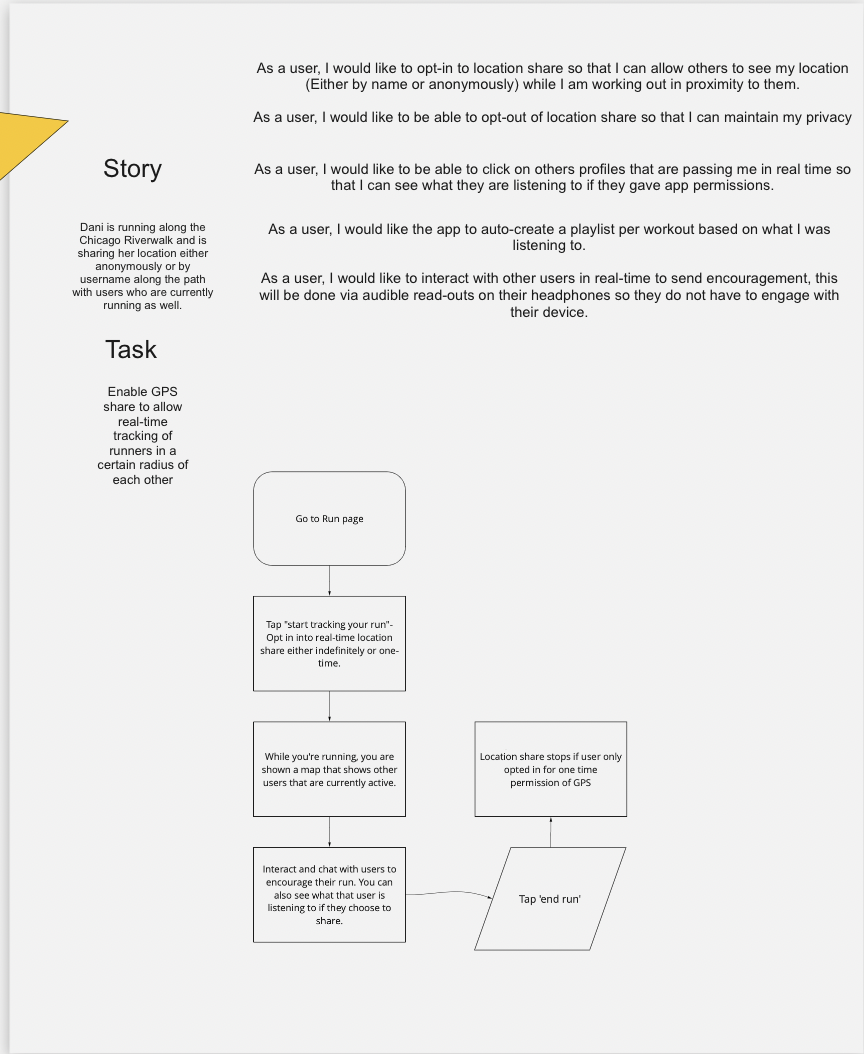
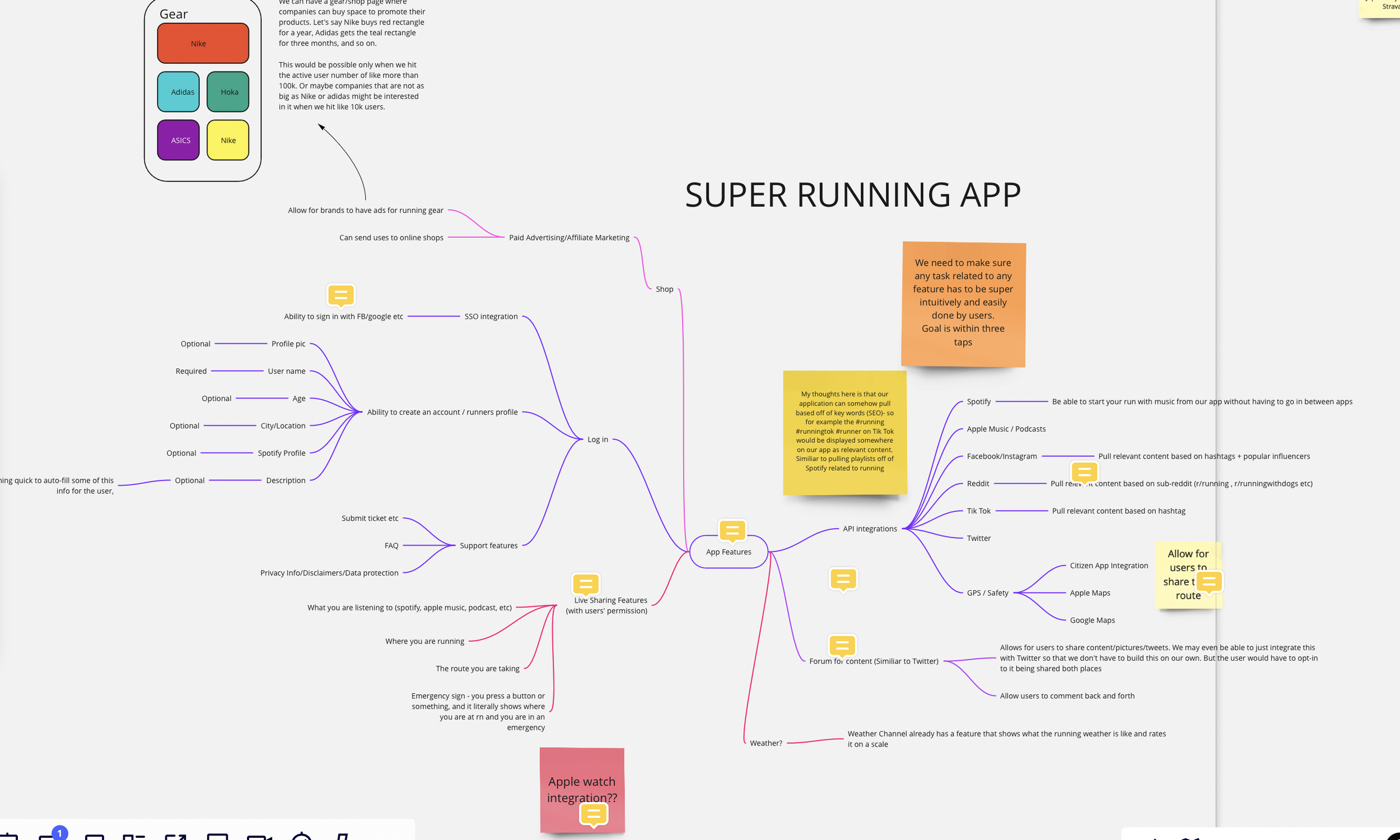



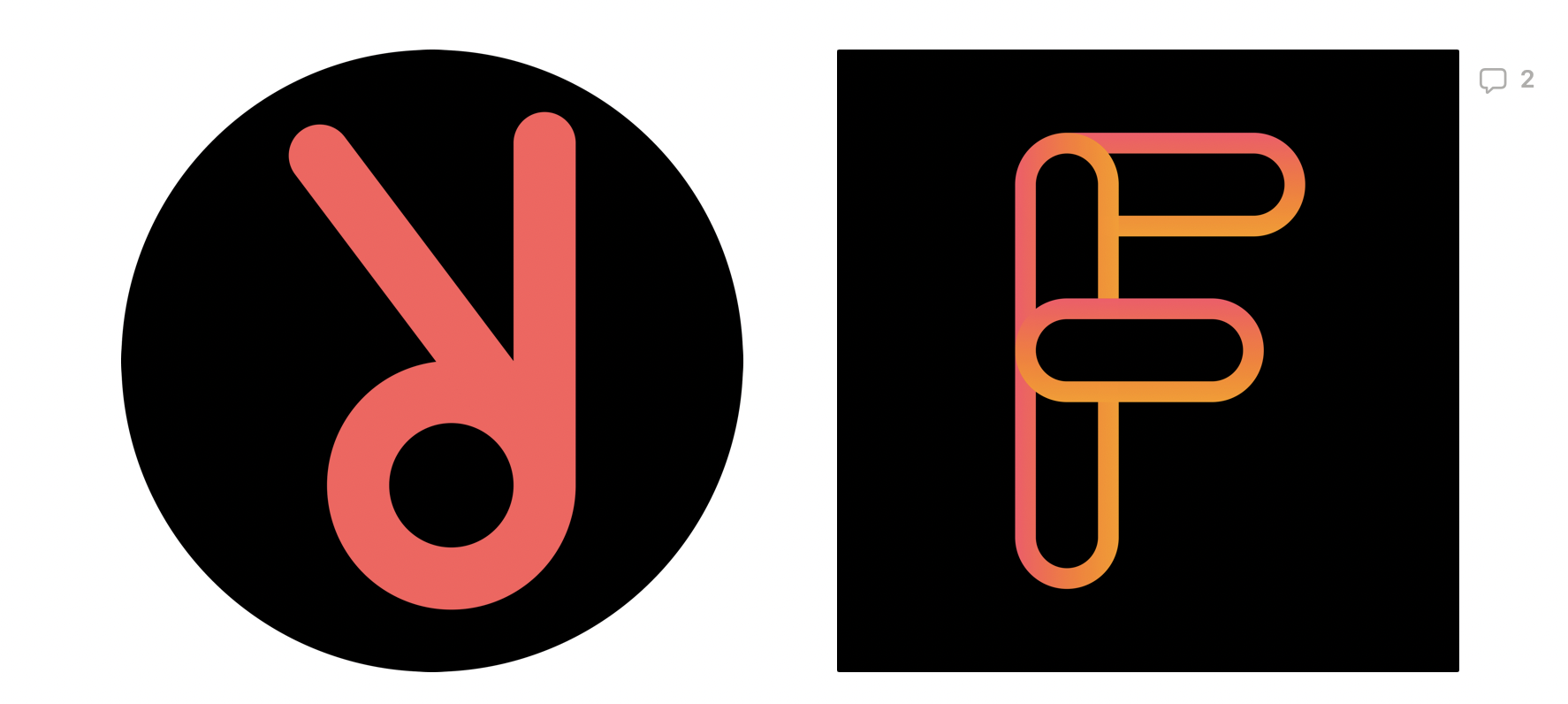
Our project state is currently within testing interaction design elements so that we can continue to iterate on how to improve user experience for runners.
In an ideal world, we would raise capital to allow us to bring on talented engineers to see this solution through. Although we are currently not raising money for this project, we did lay out our goals for how we envision scoping future state of this project:
Our goal for growth in the next three years is to use this first year to win grants/awards to be able to pay third-party developers to build the minimum viable version of our app. We will also be using this first year to establish our company and gain relevant legal protection as needed. From there, we will start to add on features and do beta testing on our app with target users in year two. For the third year, we are targeting market launch by focusing in on branding, advertising, wide adoption within our niche space, and growing loyalty for our platform.
By obtaining more capital over this three year period, we would plan to grow our team and hire experts in all different areas in the business- as well as, spend sustained periods of really understanding the psychology and behavior of recreational, advanced runners so that we can best iterate on our app to suit their needs.
More about the team.
Dani Salonen
Dani is originally from Texas but has recently relocated to the great City of Chicago. She is passionate about design thinking/human-centered design + product management. She is currently working on growing her career in those areas and establish a niche within the UX space. She holds a BSIB (Bachelor of Science in International Business) with a Concentration on Information Systems. She has lead design-thinking projects across a wide variety of industries and topics. Through this work, she has realized the impact of the design-thinking process by defining a problem statement, doing deep customer discovery work based on a targeted user persona, prototyping, and then iterating based on feedback. These projects have been conducted through mixed methods of qualitative + quantitative research by working to empathize with users on pinpoints within their journeys. She is currently working for Bain & Company as an innovation specialist. Her function in product is to holistically understand how our tech stack configures across the business and how the company can enhance their current product to better serve the experience of the client. That being said, product is at the forefront of her everyday work life and she is consistently exercising how her team can best align with dependent products in order to manage a complex system of technology.
Toma Tomonari
Toma was born and raised in Japan and moved to Arkansas in 2017 to obtain his bachelor’s degree in computer science. He is passionate about UX research/design and product development. His goal is to democratize complicated technology by designing and developing products through user-centered design. While he studies computer science and touch technology through classes and projects, he realized the importance of design in product development and pivoted his career from being a mere developer to being a technology product manager and serving as a bridge between business and engineering teams. He has been developing and practicing his design and development skills and leadership skills through multiple projects in a wide range of industry fields. He is also interested in entrepreneurial paths and always looks for problems to solve. This past year and currently, he has been working on a project to help local restaurants improve their dine-in experience through an innovative digital menu web platform. He conducted qualitative and quantitative research and developed the MVP, and he is now trying to finish developing the platform and market it to restaurants.